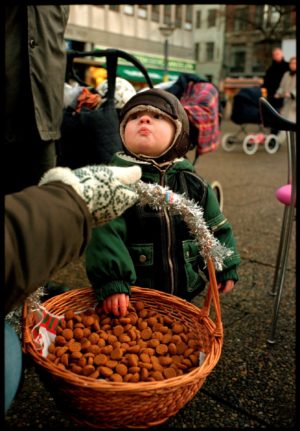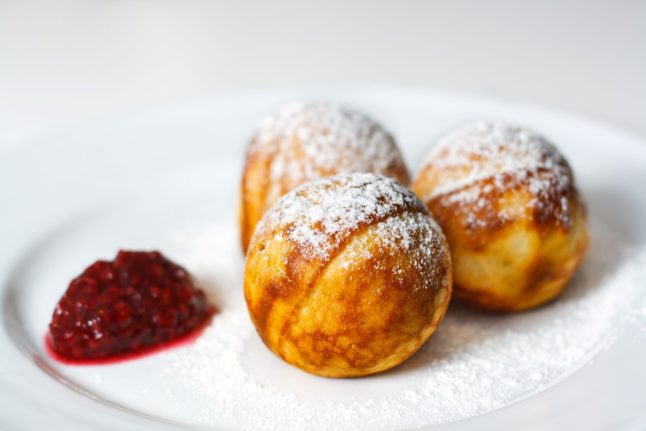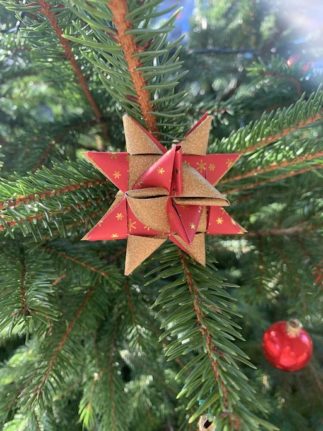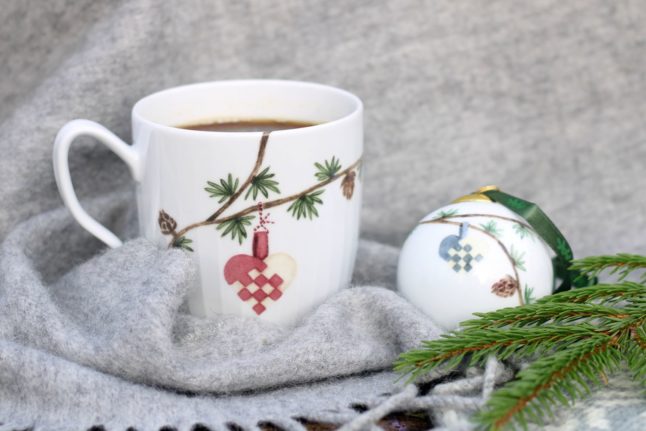Julehygge: How to get into the Christmas spirit like a Dane

Danes are big on Christmas, with the first Sunday of Advent kicking off the festive season. What can you do to embrace the Christmas spirit like a Dane?
What is julehygge?
Julehygge, made up of the word jul (Christmas) and that famous Danish word hygge, roughly translating as ‘cosiness’, is not an event as such, more just getting your friends or family together to do some Christmassy activities and get into the Christmas spirit.
Usually you’ll have some sort of festive food and activity, like baking, making paper decorations for your Christmas tree, or decorating your Advent candlestick.
If you’re meeting up on one of the four Sundays in Advent, the four Sundays leading up to Christmas, you can call it adventshygge, but you can still do these activities on a normal day and just call it julehygge instead.
What should I bake?
Obviously you can bake whatever you want, and this is a great opportunity to show off whatever kind of festive baking you do back home for big holidays, but if you want to do as the Danes do, there are a few essential cakes and biscuits you should try around Christmas time (although Danes love their cakes and this list is by no means exhaustive).
The most easily recognisable biscuits are probably peberkager, the Danish version of gingerbread, a spiced brown dough which is rolled out and cut into shapes before baking. Peberkage literally translates as “pepper cake” - biscuits are known as småkager or "small cakes" in Danish - and although they do sometimes contain black pepper, in most cases peber just refers to some sort of spiced dough, commonly flavoured with some combination of ingefær (ginger), kanel (cinnamon), kardemomme (cardamom) and nellike (cloves).
You can buy peberkagedej (gingerbread dough) in most supermarkets which you shape and bake yourself, but it’s relatively easy to make from scratch too.
Peberkager are often iced in Christmassy patterns with royal icing, or used to make a gingerbread house (peberkagehus).
A little boy eating pebernødder in 1997. Photo: Peter Elmholt/Ritzau Scanpix
Another type of biscuit popular around Christmas in Denmark is pebernødder (“pepper nuts”), which are small domed biscuits similar in size to a walnut. Again, these don’t usually contain pepper, and are often a bit lighter in colour than peberkager. You’re likely to see them served in bowls next to gløgg at Christmas hygge events in schools or workplaces for you to grab a handful and nibble on while chatting to your friends or colleagues.
Brunkager (“brown cakes”) also fall into the “spiced dough” category of Danish Christmas biscuits similar to gingerbread, although they are round, thicker than peberkager and usually contain almonds, both sliced and ground.
Rounding off the Christmas biscuits we have vaniljekranse or “vanilla wreaths” which are essentially what many people abroad know of as Danish butter cookies. These are vanilla biscuits piped with a star nozzle in a circle to make them look like Christmas wreaths, and are similar in texture to a shortbread. These are a little more difficult to make as the dough needs to be the right consistency for piping, but no one will judge you if you pick some up from the supermarket or bakery instead.
Æbleskiver. Photo: Rasmus Gundorff Sæderup on Unsplash
Finally, we can’t discuss Christmas cakes in Denmark without mentioning æbleskiver. These aren’t baked, they’re cooked in a special pan on the stove, and despite the name - which literally translates to “apple slices” - they no longer contain apples.
They look a bit like doughnuts but are essentially pancake balls, which are served alongside strawberry jam and icing sugar for dipping. You can make them yourself if you can get hold of an æbleskive pan, but they’re also sold frozen for defrosting in the microwave.
What about decorations?
Ok, so you’ve got your Christmas snacks sorted - now onto the decorations!
There are two types of paper decorations you’re likely to see people making around Christmas, julehjerter and julestjerner.
Trying and failing to fold and weave these fiddly decorations is a rite of passage for all Danes (and newcomers to Denmark), and you will no doubt just manage to figure out how to do it this Christmas season before forgetting it all and starting again from scratch on the first of Advent next year.
A Christmas star decoration. Photo: Becky Waterton/The Local
For julehjerter (“Christmas hearts”), you’ll need scissors, red and white paper or card and a lot of patience. For julestjerner (“Christmas stars”), your best bet is to buy a pack of precut strips of patterned card from supermarkets or shops like Søstrene Grene, often labelled stjernestrimler. These will usually include instructions too, but they’re often harder to understand than the instructions for building an IKEA bookshelf, so if you’re struggling you can try asking a Danish friend to show you (although they’ve probably forgotten since last year too) or look it up on YouTube.
Christmas mugs from Kähler featuring Danish Christmas hearts. Photo: Elin Melaas on Unsplash
Another common Christmas craft is decorating your Advent candles. This can either be a single kalenderlys, a countdown candle you burn every day in the run-up to Christmas, or an adventskrans, a round candlestick with space for four candles which you burn on each Advent Sunday, but the decoration is the same.
Essentially, you need some natural material, preferably green or brown. This can be bits of fir branches, pinecones, moss, trailing ivy leaves, sticks and twigs, or anything which will last a few weeks without starting to wilt and look sad. You’ll use this to decorate your Advent candles in a suitably festive way - try googling adventskrans pynt if you need inspiration. Obviously a lot of these items are flammable, especially if they’ve been sitting indoors for a few weeks drying out, so make sure you don’t leave the candles unattended so you can blow them out before they burn too low and accidentally set your decorations on fire.
If folding fiddly bits of paper or messing about with bits of damp moss isn’t your thing and you’d rather make edible decorations, you can just bake some heart-shaped peberkager (make sure to make a hole in the top before baking!) ice them if you want, and hang them on your tree with a bit of ribbon or string.
Hopefully that’s given you some ideas for how to get into the Christmas spirit, Danish style. Now all that’s left is to warm up a bottle of gløgg (mulled wine), put on some Danish julesange and start snacking on those pebernødder! Glædelig jul!
Comments (1)
See Also
What is julehygge?
Julehygge, made up of the word jul (Christmas) and that famous Danish word hygge, roughly translating as ‘cosiness’, is not an event as such, more just getting your friends or family together to do some Christmassy activities and get into the Christmas spirit.
Usually you’ll have some sort of festive food and activity, like baking, making paper decorations for your Christmas tree, or decorating your Advent candlestick.
If you’re meeting up on one of the four Sundays in Advent, the four Sundays leading up to Christmas, you can call it adventshygge, but you can still do these activities on a normal day and just call it julehygge instead.
What should I bake?
Obviously you can bake whatever you want, and this is a great opportunity to show off whatever kind of festive baking you do back home for big holidays, but if you want to do as the Danes do, there are a few essential cakes and biscuits you should try around Christmas time (although Danes love their cakes and this list is by no means exhaustive).
The most easily recognisable biscuits are probably peberkager, the Danish version of gingerbread, a spiced brown dough which is rolled out and cut into shapes before baking. Peberkage literally translates as “pepper cake” - biscuits are known as småkager or "small cakes" in Danish - and although they do sometimes contain black pepper, in most cases peber just refers to some sort of spiced dough, commonly flavoured with some combination of ingefær (ginger), kanel (cinnamon), kardemomme (cardamom) and nellike (cloves).
You can buy peberkagedej (gingerbread dough) in most supermarkets which you shape and bake yourself, but it’s relatively easy to make from scratch too.
Peberkager are often iced in Christmassy patterns with royal icing, or used to make a gingerbread house (peberkagehus).
Another type of biscuit popular around Christmas in Denmark is pebernødder (“pepper nuts”), which are small domed biscuits similar in size to a walnut. Again, these don’t usually contain pepper, and are often a bit lighter in colour than peberkager. You’re likely to see them served in bowls next to gløgg at Christmas hygge events in schools or workplaces for you to grab a handful and nibble on while chatting to your friends or colleagues.
Brunkager (“brown cakes”) also fall into the “spiced dough” category of Danish Christmas biscuits similar to gingerbread, although they are round, thicker than peberkager and usually contain almonds, both sliced and ground.
Rounding off the Christmas biscuits we have vaniljekranse or “vanilla wreaths” which are essentially what many people abroad know of as Danish butter cookies. These are vanilla biscuits piped with a star nozzle in a circle to make them look like Christmas wreaths, and are similar in texture to a shortbread. These are a little more difficult to make as the dough needs to be the right consistency for piping, but no one will judge you if you pick some up from the supermarket or bakery instead.
Finally, we can’t discuss Christmas cakes in Denmark without mentioning æbleskiver. These aren’t baked, they’re cooked in a special pan on the stove, and despite the name - which literally translates to “apple slices” - they no longer contain apples.
They look a bit like doughnuts but are essentially pancake balls, which are served alongside strawberry jam and icing sugar for dipping. You can make them yourself if you can get hold of an æbleskive pan, but they’re also sold frozen for defrosting in the microwave.
What about decorations?
Ok, so you’ve got your Christmas snacks sorted - now onto the decorations!
There are two types of paper decorations you’re likely to see people making around Christmas, julehjerter and julestjerner.
Trying and failing to fold and weave these fiddly decorations is a rite of passage for all Danes (and newcomers to Denmark), and you will no doubt just manage to figure out how to do it this Christmas season before forgetting it all and starting again from scratch on the first of Advent next year.
For julehjerter (“Christmas hearts”), you’ll need scissors, red and white paper or card and a lot of patience. For julestjerner (“Christmas stars”), your best bet is to buy a pack of precut strips of patterned card from supermarkets or shops like Søstrene Grene, often labelled stjernestrimler. These will usually include instructions too, but they’re often harder to understand than the instructions for building an IKEA bookshelf, so if you’re struggling you can try asking a Danish friend to show you (although they’ve probably forgotten since last year too) or look it up on YouTube.
Another common Christmas craft is decorating your Advent candles. This can either be a single kalenderlys, a countdown candle you burn every day in the run-up to Christmas, or an adventskrans, a round candlestick with space for four candles which you burn on each Advent Sunday, but the decoration is the same.
Essentially, you need some natural material, preferably green or brown. This can be bits of fir branches, pinecones, moss, trailing ivy leaves, sticks and twigs, or anything which will last a few weeks without starting to wilt and look sad. You’ll use this to decorate your Advent candles in a suitably festive way - try googling adventskrans pynt if you need inspiration. Obviously a lot of these items are flammable, especially if they’ve been sitting indoors for a few weeks drying out, so make sure you don’t leave the candles unattended so you can blow them out before they burn too low and accidentally set your decorations on fire.
If folding fiddly bits of paper or messing about with bits of damp moss isn’t your thing and you’d rather make edible decorations, you can just bake some heart-shaped peberkager (make sure to make a hole in the top before baking!) ice them if you want, and hang them on your tree with a bit of ribbon or string.
Hopefully that’s given you some ideas for how to get into the Christmas spirit, Danish style. Now all that’s left is to warm up a bottle of gløgg (mulled wine), put on some Danish julesange and start snacking on those pebernødder! Glædelig jul!




Join the conversation in our comments section below. Share your own views and experience and if you have a question or suggestion for our journalists then email us at [email protected].
Please keep comments civil, constructive and on topic – and make sure to read our terms of use before getting involved.
Please log in here to leave a comment.